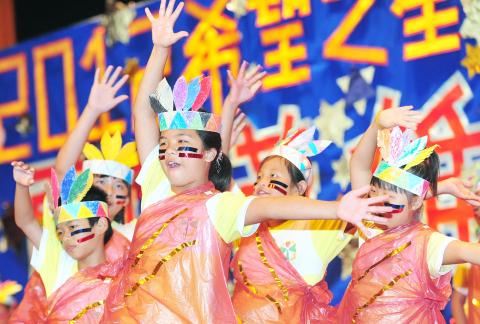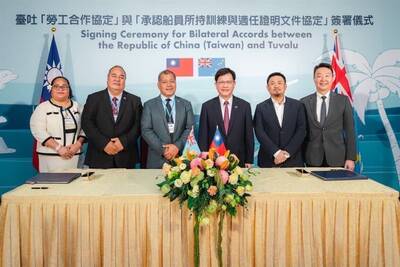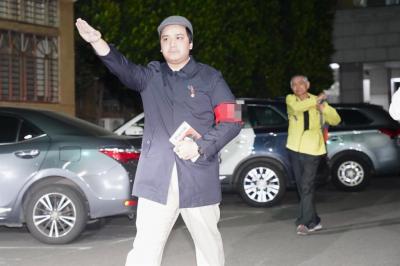New ideas and practices are needed to imporve the Cultural Heritage Preservation Act (文化資產保存法), academics and professionals said at a national forum yesterday, held by the Ministry of Culture to seek public opinions on the nation’s cultural policy.
There are currently 744 designated monuments, 1,031 historical buildings and 42 heritage sites in Taiwan. Since its implementation in 1982, the law has been amended six times.
Taiwan’s way of dealing with cultural preservation is materialistic and focuses only on “objects,” National Cheng Kung University’s professor Fu Chao-ching (傅朝卿) said.

Photo: Liao Yao-tung, Taipei Times
“We spend huge amounts of money restoring buildings, but pay no attention to people,” he said. “It is an elites’ heritage building, since you can’t hear voices from inside.”
National Taiwan University’s Graduate School of Building and Planning professor Hsia Chu-joe (夏鑄九) said this object-obsessed thinking prevents Taiwanese from seeing culture as alive.
“The idea of objects is the origin of Western modernity. This hegemonic discourse views culture preservation in a materialistic manner, as grand monuments,” he added. “Material and non-material cultural heritage is an integral whole. Only the so-called ‘experts’ can’t see it clearly.”
Hsia also said that future amendments to the law should encourage participation from local communities and non-governmental organizations and take into consideration the preservation of collective memories, grassroots identities, traditional living and craftsmanship. Otherwise, it will be difficult to properly preserve sites like Ri Xing Typography (日星鑄字行), one of the last factories in Taiwan to produce traditional Chinese-character lead type, and the Yehyin (野銀) village of the Tao Tribe on Orchid island (Lanyu, 蘭嶼), he said.
Meanwhile, Wang Hui-chun (王惠君), a professor at National Taiwan University of Science and Technology, said the notion of culture as a living thing is important when it comes to preserving Aboriginal cultures.
“We have to think what we want to preserve,” Wang said. “Culture that is constantly changing or items in people’s houses?”
Others urged the government to establish a set of operational guidelines for the implementation of the act so that there are standards for operation.
“When it comes to what to do and how to do things, there is a vast difference among local governments and committee members,” Fu said. “There are many things left unexplained, so people have to make their own decisions that differ from each other and sometimes conflict with international conventions.”
Having been isolated from the international system since its withdrawal from the UN in 1971, Taiwan has a lot of catching up to do to meet international standards, Fu added.
To archeologist and Academia Sinica research fellow Liu Yi-chang (劉益昌), the act reflects a Sino-centric way of thinking.
“Ninety-five percent of the designated historical sites are Han Chinese. Yet Han Chinese heritage only makes up for 1 percent of the human history on the island,” Liu said. “The history of human activities in Taiwan dates back to 50,000 years ago. If we think about it, then we will find the 42 designated heritage sites are far too few.”

The Ministry of Economic Affairs has fined Taobao NT$1.2 million (US$36,912) for advertisements that exceed its approved business scope, requiring the Chinese e-commerce platform to make corrections in the first half of this year or its license may be revoked. Lawmakers have called for stricter enforcement of Chinese e-commerce platforms and measures to prevent China from laundering its goods through Taiwan in response to US President Donald Trump’s heavy tariffs on China. The Legislative Yuan’s Finance Committee met today to discuss policies to prevent China from dumping goods in Taiwan, inviting government agencies to report. Democratic Progressive Party Legislator Kuo Kuo-wen (郭國文) said

The Ministry of Economic Affairs has fined Taobao NT$1.2 million (US$36,900) for advertisements that exceeded its approved business scope and ordered the Chinese e-commerce platform to make corrections in the first half of this year or its license would be revoked. Lawmakers have called for stricter supervision of Chinese e-commerce platforms and more stringent measures to prevent China from laundering its goods through Taiwan as US President Donald Trump’s administration cracks down on origin laundering. The legislature’s Finance Committee yesterday met to discuss policies to prevent China from dumping goods in Taiwan, inviting government agencies to report on the matter. Democratic Progressive Party

Taiwan and its Pacific ally Tuvalu on Tuesday signed two accords aimed at facilitating bilateral cooperation on labor affairs, according to Taiwan’s Ministry of Foreign Affairs (MOFA). The governments inked two agreements in Taipei, witnessed by Foreign Minister Lin Chia-lung (林佳龍) and visiting Deputy Tuvaluan Prime Minister Panapasi Nelesone, MOFA said in a news release. According to MOFA, the agreements will facilitate cooperation on labor issues and allow the two sides to mutually recognize seafarers’ certificates and related training. Taiwan would also continue to collaborate with Tuvalu across various fields to promote economic prosperity as well as the well-being of their

Sung Chien-liang (宋建樑), who led efforts to recall Democratic Progressive Party (DPP) Legislator Lee Kun-cheng (李坤城), was released on bail of NT$80,000 today amid outcry over his decision to wear a Nazi armband to questioning the night before. Sung arrived at the New Taipei District Prosecutors’ Office for questioning in a recall petition forgery case last night wearing a red armband bearing a swastika, carrying a copy of Adolf Hitler’s Mein Kampf and giving a Nazi salute. Sung left the building at 1:15am without the armband and covering the book with his coat. Lee said today that this is a serious